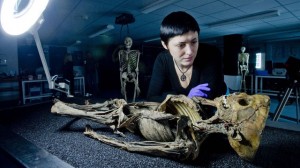A 13th century skeleton buried on the grounds of a friary in Ipswich, England, is of Tunisian origin. Nobody knows how he got all the way to England, but he lived there for at least 10 years before he died of a spinal abscess. The body was discovered in the 1990s. It’s only now that analysis has revealed his unusual background.
“It’s not just the skin tone; it’s a question of bone structure,” said Xanthe Mallett, an expert at the Center for Anatomy and Human Identification in Dundee. She said the size of the nasal bone or the shape of the orbits differed depending on whether skeletons were European or African.
“You can have an idea of where somebody is from by looking at their skeletal features,” she said.
Researchers were able to pin the man to Tunisia using isotope analysis, a technique which looks at the mix of elements that build up in a person’s teeth, bones or other tissues. Since people from different areas tend to accumulate such elements in different ways, analysis of their remains can sometimes pinpoint where they grew up, where they lived or even their diet.
“Each area has a different isotopic signature,” she said.
Carbon dating puts the skeleton to 1190-1300 A.D., at least 150 years older than the earliest post-Roman records of black people in England. There were people of African extraction in England under Rome — some slaves and soldiers, the 4th century “Ivory Bangle Lady” found buried in York — but then there’s a thousand year gap before 3 black people are mentioned in tax records.
Since he was buried in the friary, he must have been Christian, possibly a convert brought to England by Lord Tiptoth, the founder of the friary, upon his return from the 9th Crusade.

According to Bede, Hadrian (d. 710), a scholar sent to England by Pope Vitalian to accompany Theodore of Tarsus, the new archbishop of Canterbury, was an African. So that just about halves your 1000 year gap.
Bede said Hadrian was a Berber, though, like Zinedine Zidane. I suspect the article is referring to black people in particular rather than all peoples from the African continent.
Berbers are common in Tunisia as well (not sure how much so historically). Was this definitely a black African?
That’s implied by the articles, but the actual science isn’t available to me. There’s going to be a BBC program about the skeleton complete with facial reconstruction so maybe after it airs I can find out more.
Bede actually says “uir natione Afir”. Does “Afir” necessarily mean Berber or just (North) African?
Google books has come up trumps for once. Biblical Commentaries from the Canterbury school of Theodore and Hadrian by Bernhard Bischoff discusses whereabouts in N. Africa Abbot Hadrian came from. It doesn’t say anything about his ethnicity so unless we assume that all pre-Arab inhabitants of N. Africa were Berbers Hadrian could have been Black African, Berber, or general Mediterranean.
Ooh, well-spotted. :notworthy:
Whoops, sorry, I should say that I am both Bingley and rwmg. Bingley is a nom de keyboard I used to use on a Jane Austen board. No intention to deceive.
None inferred. 😆
I think that it’s about time for everyone to accept the following facts. The original peoples of the entire earth, were a genetically diverse black skin people, including all of Europe. The people in Europe today are from the black people we call Dravidians. These people who inhabited the Indian sub-continent, literally gave birth to the lighter skin people who hijacked the original black civilizations, and non civilizations of Europe. The first wave were chased out of central Asia by the black huns, and they reached europe around 1200bc. The next wave were chased out of Asia by the hybrid mongols, these were the germanics, and some came as late as 800.ad. It’s obvious that the lighter skin people came from the original blacks of Asia, from their brown eyes non brown eyes, and from their black hair non black hair.